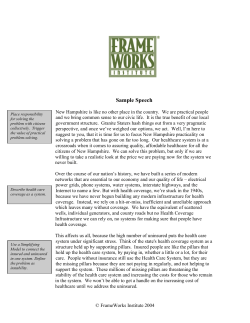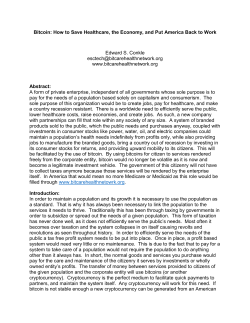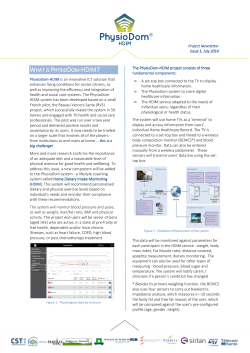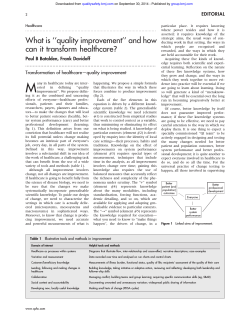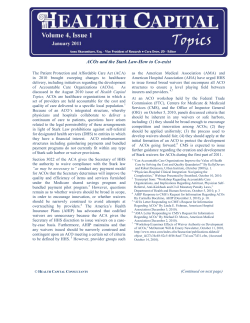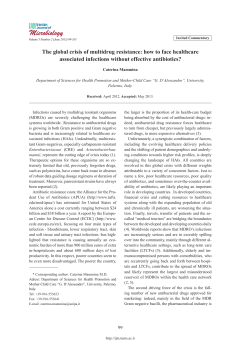
I CONTEXT
EDITORIAL Healthcare in Canada: Privatization and How to Contain It Connor Forbes, BSca, Erica Tsanga a MD Class of 2015, Faculty of Medicine, University of British Columbia n the ongoing debate on private versus public funding models for healthcare in Canada, it is interesting to note that the Canadian Medical Association (CMA) has supported privatization in the past1 and chooses to keep the debate open.2 As a powerful lobby and advisory group, their official position has transformative implications for the landscape of the job market in the form of possible remuneration model changes for physicians and other healthcare providers. Much of the discussion on whether these changes should occur centers on an evaluation of the value and pragmatism of equality in the system, but it must also be noted that the private market is not waiting around for the question to resolve itself. Regardless of whether or not it is the best option for healthcare consumers, certain factors are encouraging the growth of privatization. These factors must be addressed proactively should Canadians wish to prevent (further) tiering of the Canadian healthcare system. to increased healthcare spending come from advances in genetic research and personalized medicine. While these treatments can often be beneficial to patients, they are expensive. Costs per quality adjusted life year (QALY) for personalized drugs have been estimated between $43,000 and $170,000.6-8 Even if the cost of these treatments decline, increasing direct-to-consumer advertising of these genetic technologies can expand demand from Canadians.9 If the public system is not able to meet this increase in demand, the private system could snap up the excess and Canadian health care could quickly acquire a second tier. In 2005, a Supreme Court Case ruling in Quebec allowed an individual to access private health care as a solution to long wait times.10 This ruling sets a precedent for the nimble private market to fill in the gaps of the public system, pending rulings in other provinces across the country. In the Lancet, Kaczorowski suggests that such a model of universal coverage with additional private health insurance could help keep costs down.11 THE PRIVATIZATION CREEP PRESERVING THE PUBLIC SYSTEM In addition to supplementing the public system, the private system shows signs of infringing upon its domain. An evaluation of 130 private healthcare clinics across Canada found evidence to suspect the possibility of 89 violations of the Canada Health Act, including charging patients for medically necessary services that are covered by Canada’s publicly funded universal healthcare system.3 These clinics allow Canadians who are willing and able to pay out-of-pocket to avoid lengthy public system wait times, effectively creating a tiered healthcare system.3 Similar tiering occurs through the parallel private insurance of Workers Compensation Boards (WCB) in Canada, which undermines the goal of equal access to care since Canadians who are injured at work can receive faster treatment.4 These two cases highlight the existing encroachment of privatization into the public system. The impetus for this privatization of healthcare may be due to greater demands on the public system as a result of both changing demographics and the increasing availability of new technologies. In Canada, the percentage of the population over the age of 65 is expected to increase to nearly 24% in 2035, and healthcare costs per person rise substantially for this group.5 Further contributions The easiest solution, however, is not necessarily the most desirable one. One objection to private health care is on the grounds that access to medical support should not be dictated by an individual’s means to pay. Furthermore, between 93% and 98% of Canadians support the five principles of the Canada Health Act,12 which confirms strong support for equal access to health services across socioeconomic groups in Canada. The first thing that must be done in order to preserve the public healthcare system is for the Canadian government to save it now. Hogan and Hogan recommend exactly this, believing that the current financial climate allows for this kind of fiscal responsibility, and warning of dire consequences should Canada fail to prepare for the coming increases in cost.5 The lack of a contingency fund will allow the overflow in demand to be lapped up by the private system, accelerating its growth. A substantial preparatory fund will allow the public system to absorb any strain instead. If Canadians want health care to stay public, there is also a need to change attitudes and expectations. Stuart and Adams argue that the sustainability of the public healthcare system depends on a cultural shift: consumers must accept that not all medical procedures will be covered by the public system.12 To CONTEXT I Correspondence Connor Forbes, Erica Tsang, internal.editor@ubcmj.com 4 UBCMJ | SEPTEMBER 2012 4(1) | www.ubcmj.com EDITORIAL keep healthcare public, Canadians will have to be comfortable with a system that does not provide low-yield medical treatment for all ailments.12 Whether or not Canadians will be satisfied with this level of care or would prefer to push for the ability to spend on more extensive treatments remains to be seen. Ultimately, the debate of public or private is one that rests on the will of the Canadian people. It would be a pity, however, to see strong beliefs in equality buried by a lack of public preparation. REFERENCES 1. 2. 3. 4. Webster P. Canadian medical association champions private medicine. Lancet 2006;368:1315-1316. Kondro W. “Fuzzy” elements of CMA transformation blueprint may yet undermine medicare, critics say. CMAJ 2010;182:3350-3353. Mehra N. Eroding public medicare: lessons and consequences of for-profit health care across Canada. Ottawa, ON: Ontario Health Coalition; 2008 Oct. 169 p. Davidson A. Parallel payers, privatization and two-tier healthcare in Canada. Healthcare Papers 2008;8:16-20. 5. Hogan S, Hogan S. How will the ageing of the population affect health care needs and costs in the foreseeable future? Ottawa, ON: Commission on the Future of Health Care in Canada; 2002 Oct. 22 p. Discussion Paper No:25. 6. Eckman MH, Rosand J, Greenberg S, Gage B. Cost-effectiveness of using pharmacogenetic information in Warfarin dosing for patients with nonvalvular atrial fibrillation. Ann Int Med 2009;150:73-83. 7. Pharmaceutical Management Agency. Trastuzumab (Herceptin) in HER2 positive early stage primary breast cancer technology assessment. 2007 April [cited 2012 June 26]. Available from http://www.pharmac.govt. nz/2007/04/13/030307c.pdf 8. Schackman BR, Scott CA, Walensky RP, Losina E, Freedberg KA, Sax PE. The cost-effectiveness of HLA-B*5701 genetic screening to guide initial antiretroviral therapy for HIV. AIDS 2008;22:2025-2037. 9. Mintzes B, Barer ML, Kravitz RL, Bassett K, Lexchin J, Kazanjian A, Evans RG, Pan R, Marion SA. How does direct-to-consumer advertising (DTCA) affect prescribing? A survey in primary care environments with and without legal DTCA. CMAJ 2003;169:405-412. 10. Chaoulli v. Quebec (Attorney General). 2005 SCC 35. 11. Kaczorowski J. Who still has the worst health system of them all? Lancet 2010;376:1146. 12. Stuart N, Adams J. The sustainability of Canada’s healthcare system: a framework for advancing the debate. Healthcare Quarterly 2007;10:96-103. UBCMJ | SEPTEMBER 2012 4(1) | www.ubcmj.com 5
© Copyright 2025








